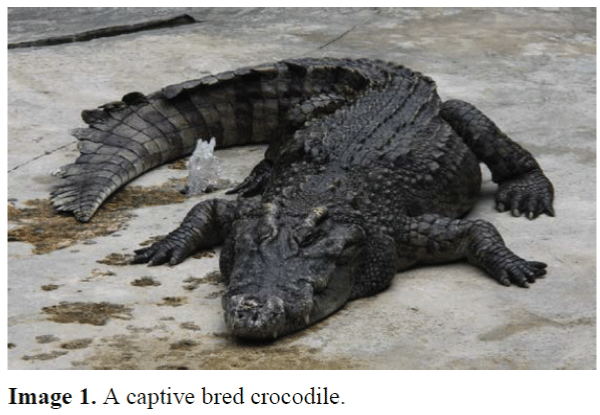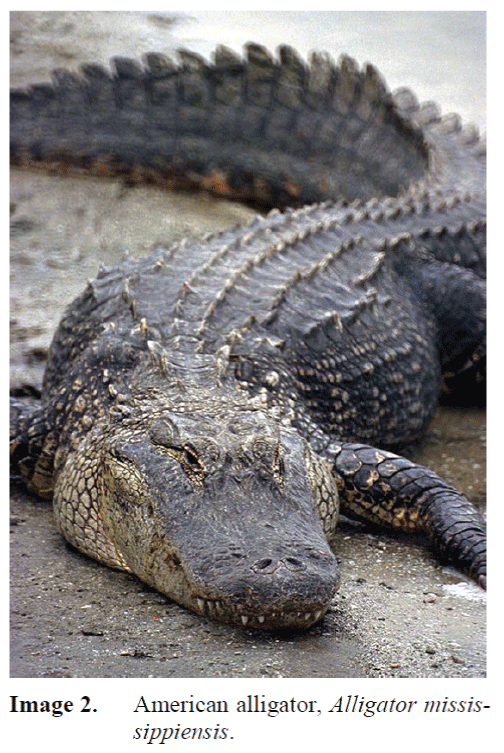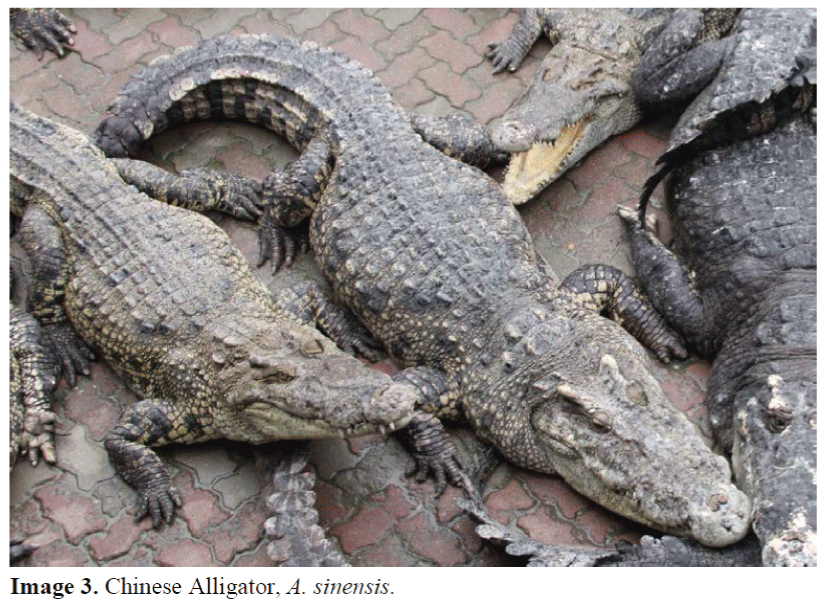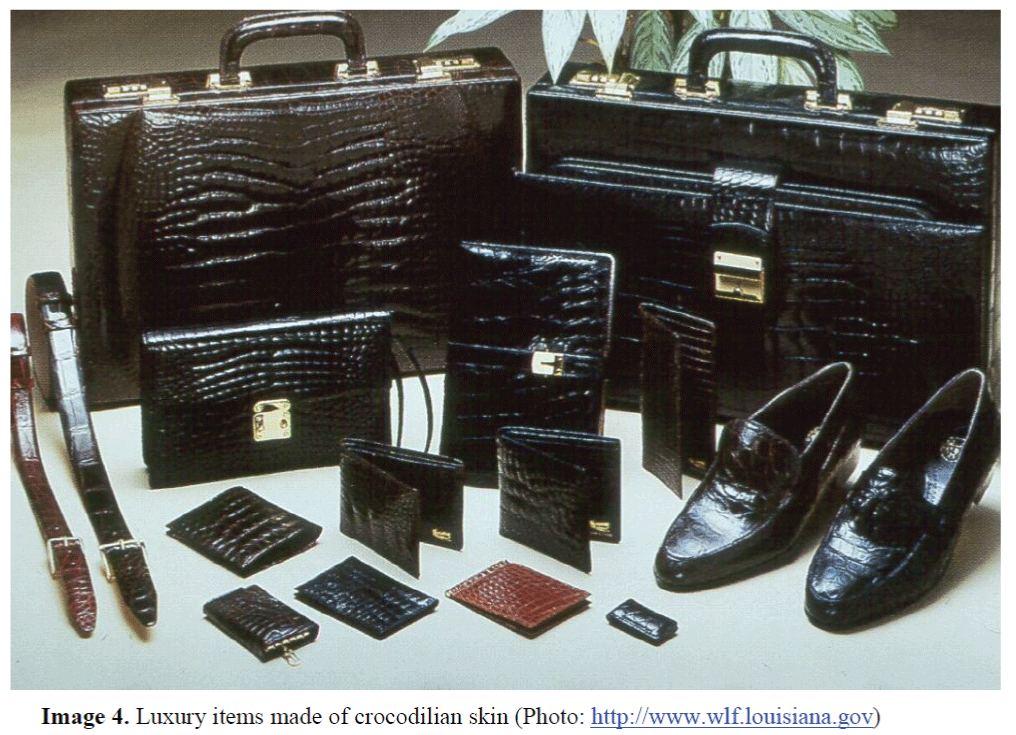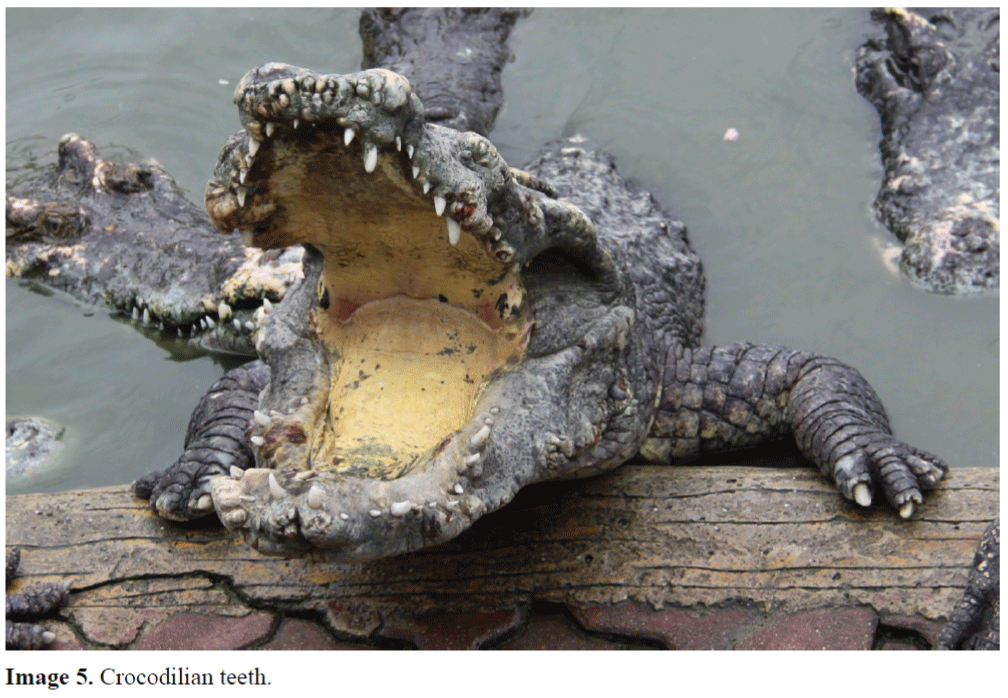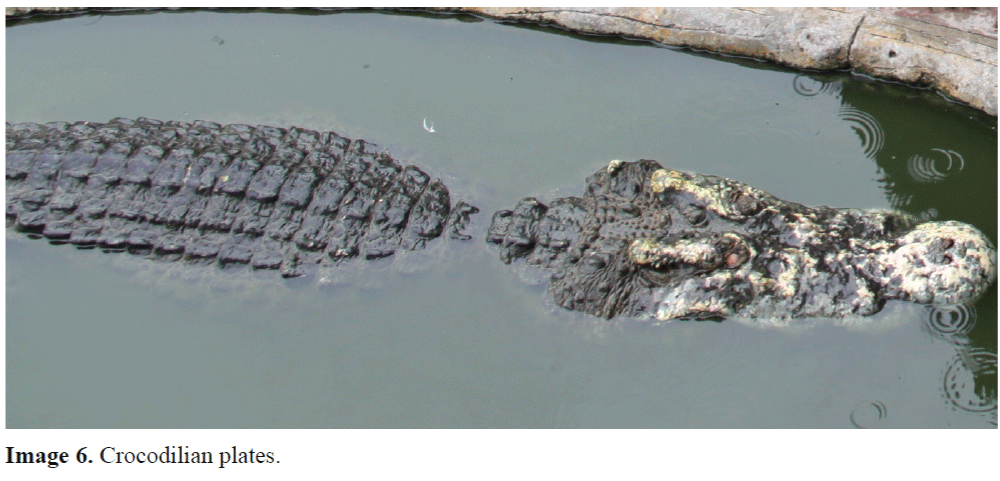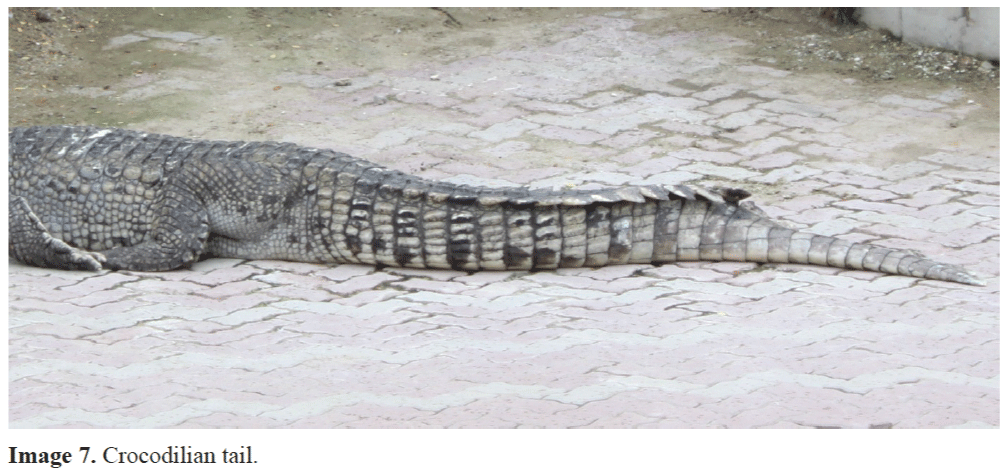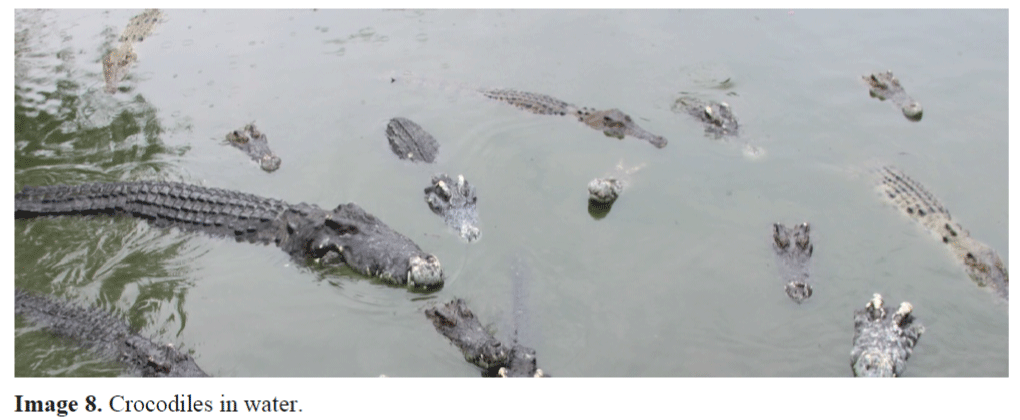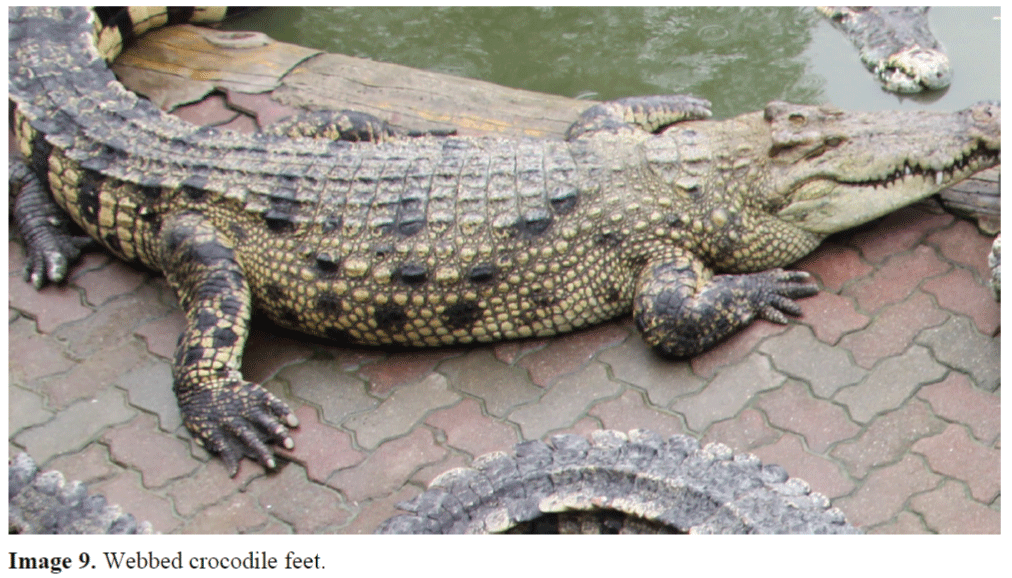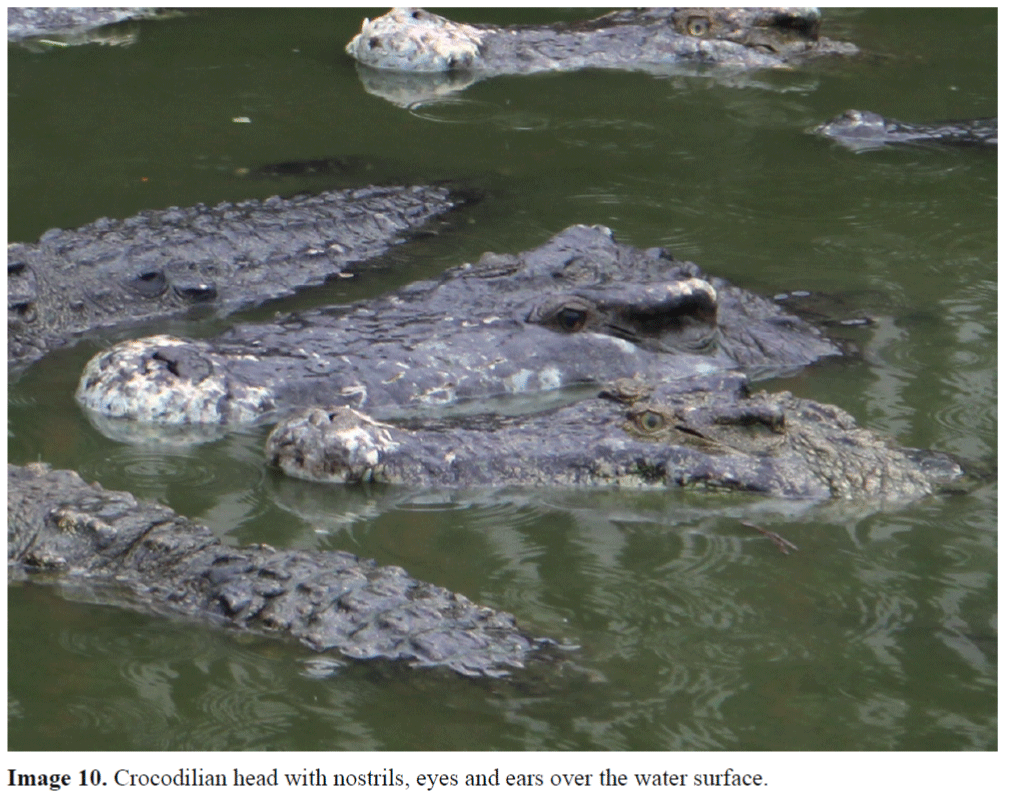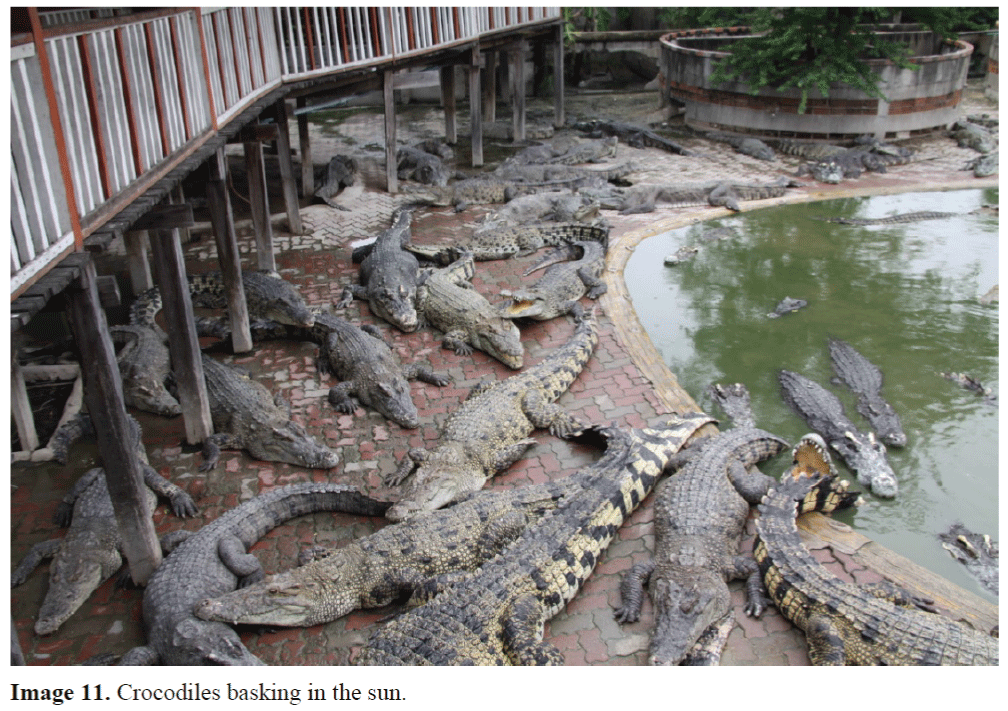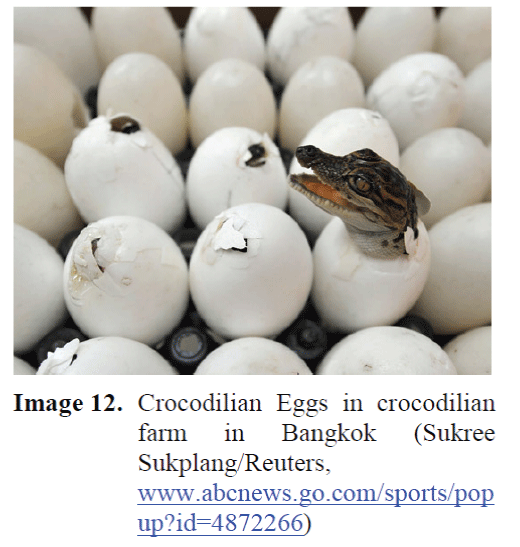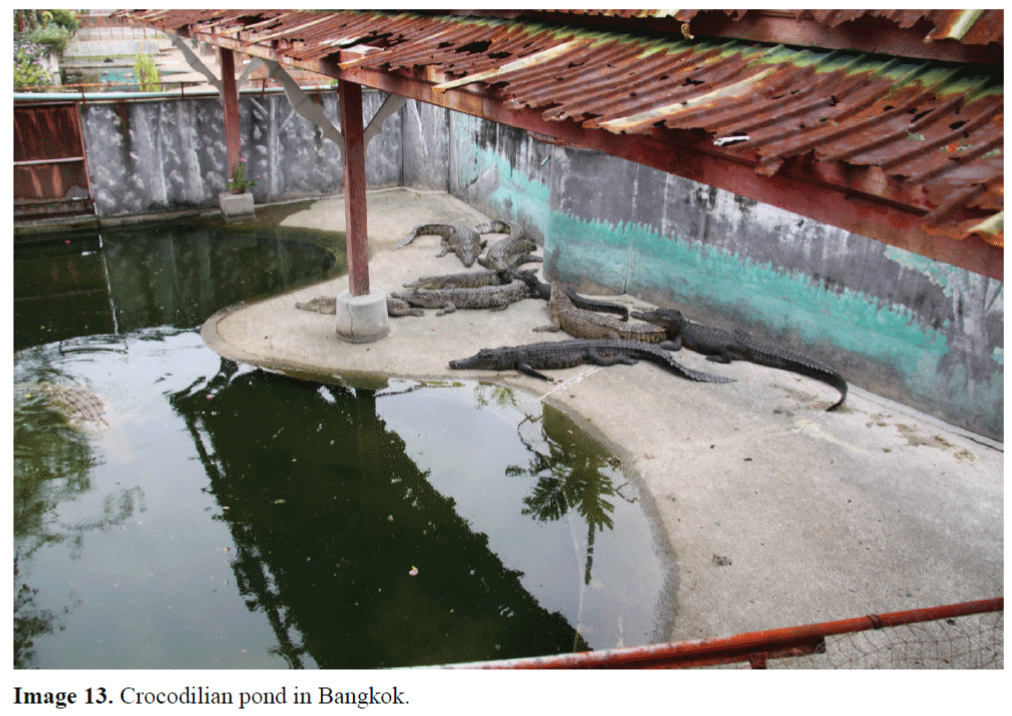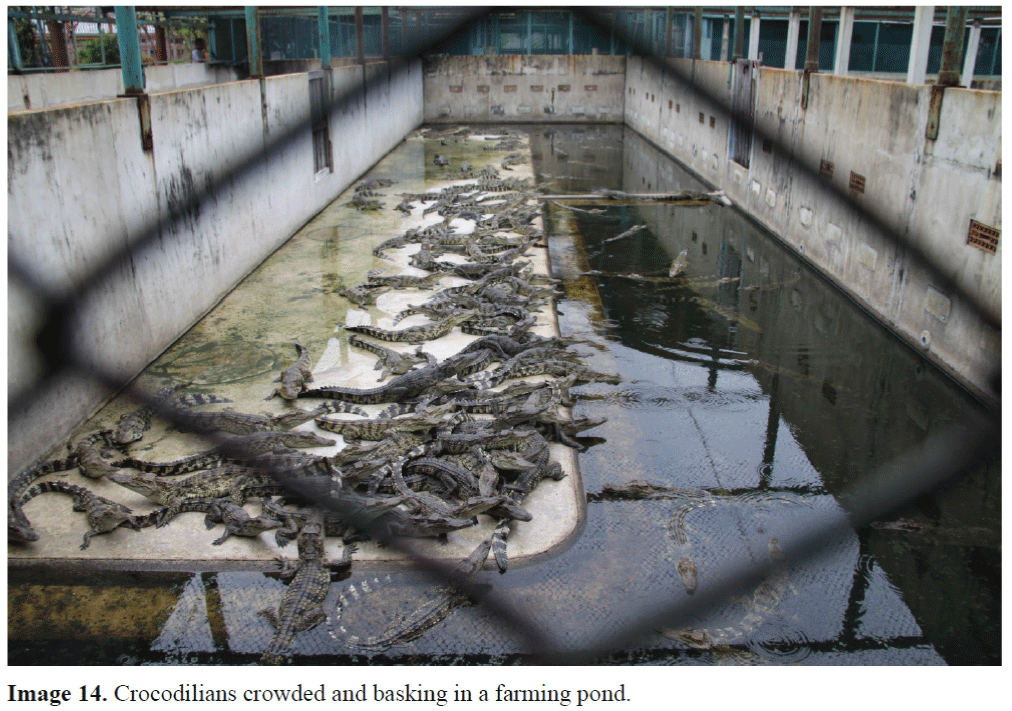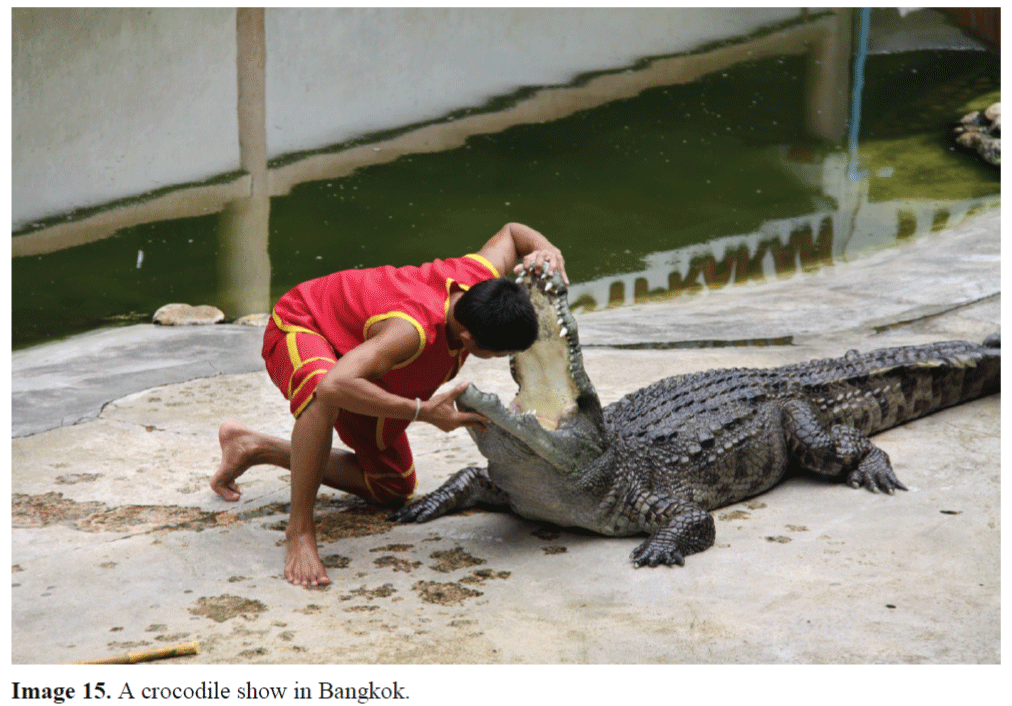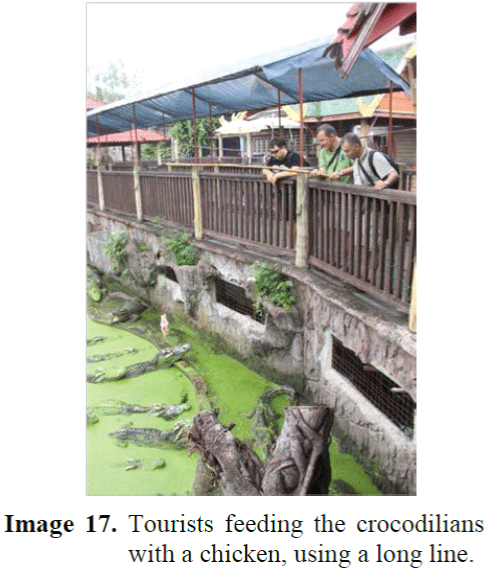Keywords
Crocodile, crocodile farming, geothermal, alligator
Introduction
Crocodiles (Image 1.) are regarded both as fascinating and horrifying by people. Crocodile farm is a closed-cycle captive breeding estab-lishment that is managed so that crocodiles have artificial housing, veterinary care, artificially supplied food and protection from predators. This culture application is mostly intended for pro-ducing skins, meat, oil and claws (Stickney, 2000).
Image 1. A captive bred crocodile.
Holding crocodiles in captivity for breeding purposes is not a new idea. Crocodiles have been bred in farms since early 20th century. The ma-jority of these farms were tourist attractions with wild caught alligators or crocodiles under captiv-ity (Masser, 1993; Stickney, 2000). The St. Au-gustine Alligator Farm Zoological Park, estab-lished in 1893, is an example of this early type of alligator farming. In 1960s commercial opera-tions that either harvested eggs from the wild or bred alligators on-site began to appear. Farming applications started with diminishing stocks of wild alligators, which had been hunted nearly to extinction around this time. Advances in envi-ronmentally controlled production methods dur-ing the 1980s improved survival rates, allowed sex determination and produced market size (1.2 meters) alligators in two years time (Stickney, 2000; Peucker and Jack, 2006; Masser, 1993).
As the American Alligator was placed under official protection in 1967 farming alligators for skins became the most viable option for produc-ing leather. Mostly concentrated in the Southern U.S. of Louisiana, Florida, and Georgia, the practice quickly spread to other nations. Both the American and Chinese Alligator are farmed in-tensively at the present (Thorbjarnarson, 1992; Blake et al., 1975; Ogden, 1978; Alpbaz, 2005).
In Africa, many ranches prefer Nile Croco-diles for farming. Saltwater crocodiles are pre-ferred in Australia. The smaller caimans are gen-erally not of enough market value to farm, though some captive breeding of the spectacled cai-man does take place in South America (Revol, 1995; Stickney, 2000; Tisdell, 2005).
Crocodile (Crocodylus niloticus) farming has been practiced for the past 25 years in southern Africa. In 1963, crocodile farmers were allowed to collect a prescribed number of crocodile eggs from the wild and incubate them in captivity with a license given in Zimbabwe. The captive bred crocodiles were than slaughtered and exported to other countries. In South Africa, crocodile farm-ing started in the late 1960s and 40 farms were licensed by 1992. Crocodile industry tradition-ally focuses on producing skins used in the pro-duction of high-quality fashion accessories. The increase in production costs in this industry forced the farmers to look at alternative means of increasing the profitability of this farming style. Tourism and meat production have been incorpo-rated into the major component of skin produc-tion. In South Africa, most of the crocodile meat produced is either exported or sold to the restau-rant trade or used as unprocessed crocodile feed on the farm (Hoffman, 2000).
Crocodile farming first started with the de-mand for their skins. These skins were as valua-ble as hundreds of dollars apiece. With the growing farming applications, alligator meat be-gan to be sold and shipped around the world. Al-ligator meat is a high priced food in select restau-rants, and in China it is regarded as medicinal food which has protective properties against can-cer, these beliefs does not have any scientific ba-sis. Advances combined with high demand for alligator skins resulted in an expansion in alliga-tor farming industry during 1980s (MacGregor, 2006).
American alligator (Alligator mississip-piensis, Image 2) is a member of Crocodilia. This order includes alligators, crocodiles and caimans. American alligator can grow up to 5 meters or more in length. Another species of alligator is A. sinensis (Image 3) which is found in China. This species is endangered. Crocodiles inhabit tropical regions of the world. There are 15 species of crocodiles around the world. Four species of caimans are smaller compared to alligators and crocodiles. All of these species are valued for their skins (Image 4). They have approximately the same value based on length and grade. The commercial importance of these species led to the decline in wild populations of crocodilians and many species are regarded as endangered throughout the world. There are more than 500 farms in 47 countries around the globe with a worldwide crocodilian population of more than 1 million on farm (Staton et al., 1977; Lance, 1989; Joanen et al., 1989; Stickney, 2000).
Image 2. American alligator, Alligator missis-sippiensis.
Image 3. Chinese Alligator, A. sinensis.
Image 4. Luxury items made of crocodilian skin (Photo: https://www.wlf.louisiana.gov)
Biology, Ecology and Life History
Crocodilians have distinctive features such as almost completely four-chambered heart, teeth that are set into sockets in the jaw (Image 5), a palate that separates the mouth from the nasal chambers, and spongy lungs. These animals also have a protective covering of partially calcified, horny plates on their back (Image 6). These plates are not connected with each other, and are set into the thick, scaly skin, allowing a great freedom of movement. Crocodilians have a heavy body with squat legs and a large, strong, scale-ridged tail (Staton et al., 1977; Hara et al., 1978; Lance, 1989; Joanen et al., 1989; Stickney, 2000).
Image 5. Crocodilian teeth.
Image 6. Crocodilian plates.
The tail (Image 7) has sinusoidal motions which are used to propel while swimming. Sometimes the tail is used as a weapon which is used for both offense and defense. Crocodilians can move very quickly although they are seen unmotile for long periods. They are known to lift their body off the ground and run on with four legs (Stickney, 2000).
Image 7. Crocodilian tail.
Crocodilians are adapted to live in water (Image 8). Their feet are webbed (Image 9) to swim in water and nostrils, eyes and ears are located high on the head (Image 10). This localization is ef-fective to hide their body in the water without being seen by their prey and hunt. Eyes of a crocodilian are covered by a semi-transparent membrane, nostrils and ears are sealed with skin to stop inflow of water. Crocodiles prefer to float submerged with only their eyes and nostrils exposed. This is accomplished by regulating the amount of air held in the lungs. Researchers has concluded that stones found in crocodile sto-machs are used to control buoyancy. These sto-nes takes up %1 of the body weight. (Hutton, 1987; Perez, 1989; Stickney, 2000).
Image 8. Crocodiles in water.
Image 9. Webbed crocodile feet.
Image 10. Crocodilian head with nostrils, eyes and ears over the water surface.
Crocodilians are poikilothermic; they do not re-gulate their body temperature. They warm them-selves by basking (Image 11) in the sun which takes up much of their time. Most species are nocturnal predators, if prey is available, they are known to hunt during day time (Banerjee, 1989; Wallace et al., 2008).
Image 11. Crocodiles basking in the sun.
Crocodilians are poikilothermic; they do not regulate their body temperature. They warm themselves by basking (Image 11) in the sun which takes up much of their time. Most species are nocturnal predators, if prey is available; they are known to hunt during day time (Banerjee, 1989; Wallace et al., 2008).
During breeding seasons male crocodiles be-come teritorial and chase other males from areas where there is good basking, nesting and feeding grounds. Territory proclaiming is achieved mostly by loud roaring and jaw snapping. Male crocodiles chase away any intruders; matching males might get in fights resulting in the death of one of the indivicuals. Females choose this pro-claimed area for breeding if they consider this region high quality (Staton, 1977; Ogden, 1978; Hara, 1978; Joanen, 1989; Kofron, 1989).
Crocodilians are predators which have large strong jaws that grip their prey with numerous sharp teeth. Their teeth are not for cutting. Croc-odiles tear larger prey by rolling their body while the prey is gripped in their jaw. Crocodiles leave larger prey to decompose and consume later when their skin is soft and able to be torn apart (Hutton, 1987; Stickney, 2000).
All crocodilians are oviparous. They lay hard shelled white eggs (Image 12). They make nests with vegetation or dig pits on the beach. The eggs are incubated by the heat of the decomposing plants positioned in the nest. Females guard their nests (Staton, 1977; Ogden, 1978; Hara, 1978; Joanen, 1989; Kofron, 1989).
Image 12. Crocodilian Eggs in crocodilian farm in Bangkok (Sukree Sukplang/Reuters, www.abcnews.go.com/sports/popup?id=4872266)
Crocodilians are known to inhabit all types of fresh water to slightly brackish water bodies. Males grow larger than females. Growth rates and maturity depends on the temperatures related with the climate and the available food supply in the region they reside. Sexual maturity can take 9 years up to 18 years. Optimum growth rates are achieved at 29-330C. Below 21 degrees, no visi-ble growth can be seen and above 34 degree sometimes results in death (Lance, 1989).
Crocodilian diet changes with size. Small crocodilians consume mostly crayfish and insects As they grow they start feeding on fish. Mam-mals like muskrats and nutria are amongst ani-mals in adult crocodilian diet. Large crocodilians are known to feed on reptiles, birds and small crocodilians. They consume carrion (rotten carcass) whenever available (Banerjee, 1989; Wal-lace et al., 2008).
Adult females do not migrate long distances. They prefer heavily vegetated marsh-type eco-systems (Stickney, 2000). Males are territorial and prefer open waters. Larger males have more chance of successful breeding (Lance, 1989).
Depending on the climate and environmental conditions, crocodilians breed from April to July. Courtship and breeding takes place in deep (2m) open waters. Vigorous swimming and bellowing are common during courtship. Although both sexes bellow, male is much more bass and vocal compared to the female. Courtship is known to occur after sunrise and lasts for 45 minutes. Re-peated copulation is commonly observed (Staton, 1977; Ogden, 1978; Hara, 1978; Joanen, 1989; Kofron, 1989; Masser, 1993; Tisdell, 2005).
Following occupation and mating, females choose isolated ponds preferably in vegetated ar-eas for nesting. Nesting starts after two to three weeks after mating. Females build their nests and lay their eggs during night time. Females nests once a year and not every year. 20 to 60 eggs are laid in the nest built by the female with sur-rounding vegetation and soil. After laying eggs, females cover these eggs with 25 cm thick vege-tation. Nests are guarded by the females against predators (Staton, 1977; Ogden, 1978; Hara, 1978; Joanen, 1989; Kofron, 1989; Masser, 1993; Stickney,2000; Tisdell, 2005).
Incubation time varies with species and tem-perature. Nile Crocodiles hatches in 11 to 14 weeks. Lizards, mongooses, dogs, raccoons and evenants are natural predators for both the eggs and infants of crocodiles. Warm summer time temperatures, combined with heat generated from the decaying mound of vegetation, maintains temperatures between 24-33°C and relative hu-midity of 94-99% in the nest. Eggs hatch after 65 days after constant temperature over 28°C. In nature, hatching results in less than % 60 suc-cesses and survival of a youngling to 1.2 m is less than %17. When an alligator reaches 1.2 m in length, it has few predators other than larger crocodiles and humans (Staton, 1977; Ogden, 1978; Hara, 1978; Joanen, 1989; Kofron, 1989; Masser, 1993; Stickney, 2000; Tisdell 2005).
An infant crocodilian breaks out of the shell with “egg tooth” (Image 12). Sometimes female crocodile helps the infants by cracking the eggs with their mouths. All eggs are hatched within a short time of each other. Females protect the in-fants by keeping them close and allowing them to climb on their heads and body. This stage of the crocodilians is very vulnerable because of the predation (Stickney, 2000).
Controlled Breeding
In some areas it is possible to collect eggs from the wild. This is mostly approved in areas with high populations to ensure population con-trol. But mostly it is forbidden to collect these eggs from the wild because of the endangered status. Crocodilian farmers must obtain their eggs by buying from existing alligator farms if they do not have broodstock. It is a well known fact that captive alligators behave differently compared to wild specimens. It is not easy to achieve success-ful reproduction. Farm raised alligators accepts crowding better than wilds ones as well as con-finement. The social establishment amongst the captive alligators allows them to breed more fre-quently than the wild alligators. It is very im-portant to establish ponds with the right land to water ratio to ensure successful breeding. Ponds must be built 3-1 land-water ratio with a long shoreline (Image 13 and Image 14). The ponds should be built in such a way that male alligators don’t see each other during mating season. This will decrease the amount of fights between males. Breeding ponds should have 1.8m depth during the breeding season with drains. Drains are necessary to drain water to capture alligators if needed. Alligators are known to dig and climb, because of this, shorelines in the ponds should not be closer than 30 m to the fences (Revol, 1995; Stickney, 2000; Yılmaz, 2000; Tisdell, 2005; Peucker et al., 2006; Macgregor, 2006).
Image 13. Crocodilian pond in Bangkok.
Image 14. Crocodilians crowded and basking in a farming pond.
Vegetation around the pond is very important. Dense vegetation provides nesting material, cover and shade. Natural wetland plants, tall and deep grasses and hay sacks provide good materi-als for the alligators. Shades are important to pre-vent overheating. Without adequate shades, alli-gators will burrow (Revol, 1995; Tisdell, 2005; Peucker et al., 2006; Macgregor, 2006).
Alligator stocking is important as well as pond design. Overcrowding of a pond may result in lethal fights between the residents. Farming ponds should at least have 5 ha of area with 25 to 50 individuals per 1 ha. It is essential to stock 6 years to 20 years old individuals for a successful breeding. Best breeding age for females are 8 to 10 years old. Female to male ratio has to be near 3 to 1 and less than 4 to 1 (Revol, 1995; Stickney, 2000; Yılmaz, 2000; Tisdell, 2005; Peucker et al., 2006; Macgregor, 2006).
Feeding should be utilized from different sta-tions around the ponds to ensure homogenous allocation of the adults. Basking areas and the shoreline is the best places for feeding. Feeding should be practiced when the temperature is over 21°C which is the spring time till it falls below 21°C in fall and winter. Alligators are fed 4-6% of body weight per week. Percentage rises to 6 in summer time. Once per week is enough for feeding the adults. For a good egg development it is essential to feed the females during early fall. Over feeding the adults does not result in good egg developments. Adult breeders should not be disturbed during February to August through egg maturation, courting and nesting. Handling of animals and ponds should be done in between September and January. Nesting success depends on many variables like pond design, stocking density, social structure and diet. As mentioned before, nesting success is around %60 in wild populations while it is lower in captivity. Egg amount is different between individuals, larger and older females lay more eggs. Egg amount should be around 35-40 eggs. Fertility as well as survival differs between 70-95% (Revol, 1995; Stickney, 2000; Yılmaz, 2000; Tisdell, 2005; Peucker et al., 2006; Macgregor, 2006).
Vegetation around the pond is very important. Dense vegetation provides nesting material, cover and shade. Natural wetland plants, tall and deep grasses and hay sacks provide good materi-als for the alligators. Shades are important to pre-vent overheating. Without adequate shades, alli-gators will burrow (Revol, 1995; Tisdell, 2005; Peucker et al., 2006; Macgregor, 2006).
Alligator stocking is important as well as pond design. Overcrowding of a pond may result in lethal fights between the residents. Farming ponds should at least have 5 ha of area with 25 to 50 individuals per 1 ha. It is essential to stock 6 years to 20 years old individuals for a successful breeding. Best breeding age for females are 8 to 10 years old. Female to male ratio has to be near 3 to 1 and less than 4 to 1 (Revol, 1995; Stickney, 2000; Yılmaz, 2000; Tisdell, 2005; Peucker et al., 2006; Macgregor, 2006).
Feeding should be utilized from different sta-tions around the ponds to ensure homogenous allocation of the adults. Basking areas and the shoreline is the best places for feeding. Feeding should be practiced when the temperature is over 21oC which is the spring time till it falls below 21oC in fall and winter. Alligators are fed 4-6% of body weight per week. Percentage rises to 6 in summer time. Once per week is enough for feeding the adults. For a good egg development it is essential to feed the females during early fall. Over feeding the adults does not result in good egg developments. Adult breeders should not be disturbed during February to August through egg maturation, courting and nesting. Handling of animals and ponds should be done in between September and January. Nesting success depends on many variables like pond design, stocking density, social structure and diet. As mentioned before, nesting success is around %60 in wild populations while it is lower in captivity. Egg amount is different between individuals, larger and older females lay more eggs. Egg amount should be around 35-40 eggs. Fertility as well as survival differs between 70-95% (Revol, 1995; Stickney, 2000; Yılmaz, 2000; Tisdell, 2005; Peucker et al., 2006; Macgregor, 2006).
Basic crocodile welfare requirements
A crocodilian farmer should provide some necessary conditions to achieve good health and growth for the animals in their farm;
a) There should be appropriate food and water sufficient for healthy culture conditions.
b) Area of the farm should be suitable for the culture conditions and crocodiles/alligators to exhibit normal behavior.
c) Adequate protection from predation should be provided for the animals
d) Animals should be protected from diseases and if exposed they should be cared as fit
Crocodile farming has the potential to provide an answer for the future management of this spe-cies. Controlled breeding and support of the natu-ral habitats will result in a sustainable crocodile production for future generations. Espacially in developing countries, farming will result in re-newable resourse management rather than ex-ploitation and destruction of the species. (Blake et al., 1975; Revol, 1995; Stickney, 2000; Yılmaz, 2000; Tisdell, 2005; Peucker et al., 2006; Macgregor, 2006).
Crocodile Meat as by-product
Crocodile farming is a growing industry. With the growth in this industry, farmers needed more than the skins to be able to profit. Firstly meat was seen as a byproduct for the farmers but lately it started to find its way as an important eco-nomic source for the farmers. A single South Af-rican crocodile farm can harvest 20.000 individu-als per year and all this meat is exported to Eu-rope and Far East. Meat production resulted in focus to growth characteristics rather than skin yield. Better feeding regimes, feed compositions, studies on chemical compositions, nutritional values and better meat processing techniques are needed for further growth of this industry. Croc-odile meat can be marketed as a healthy food for its unsaturated lipid fatty acid profile and its low sodium content. It is accepted as a unique deli-cacy in luxury restaurants for tourists (Hoffman et al., 2000).
Current state of global crocodile trade
Global statistics about crocodile trade mostly depends on the reports submitted to CITES by the countries. Limitations of data are directly re-lated to the lack of these reports which are not submitted by those countries. It is important to differentiate available data in terms of whole skin, live animal or skin parts to be able to pro-vide accurate statistics. It is known that live ani-mals might be reported as skins and skin parts might be reported as whole skins in some occa-sions. This kind of misreporting results in false statistics and it is essential to cross check these reports to obtain accurate statistics. Table 1 shows global crocodile trade statistics taken from the 2011 IACTS report (Caldwell 2010).
Crocodile meat is the main by-product for this type of aquaculture. Statistics shows that 400 tonnes per year is in circulation since 1990 inter-nationally. The main species used for meat are American crocodiles, Nile crocodiles and Sia-mese crocodiles. China and Hong Kong are the main importers of crocodile meat. It is known that blood (pharmaceuticals), bones, fat (tradi-tional medicines), teeth, heads, skulls (tourist cu-rios) and others parts of the crocodiles are also used. There is a minor trade in live crocodilians between zoos and for pet trade where it is li-censed. Live crocodiles are traded between countries as hatchlings for farming purposes in larger numbers (eg 268.000 hatchling Nile Croc-odiles from Mozambique to Zimbabwe and South Africa in a 7-year period; Siamese Crocodile hatchlings from Cambodia to Vietnam and Thai-land) (Caldwell 2010).
Caldwell (2010), states that over all total number of skins entering international circulation is about 1.2 million. This is a return to the levels of 1999-2005. The amount of skin peaked in 2006 with a number of 1.8 million. During the ten year period between 1999-2008 the species composition of the skin trade varied. Diversifica-tions mostly started in 2001 with Crocodylus acutus from Columbia and Honduras, Caiman latirostris from Argentina and Brazil, Caiman crocodilus crocodilus from Guyana, entering the international trade. Caiman yacare was first ex-ported in 2005. There is a decrease in alligator missisipiensis exports from United States of America in the last two years. This decrease is linked with two major hurricanes that altered the local conditions. The general global economic crysis might also be a reason to describe this de-crease in the exports. Crocodylus niloticus is in international trade with 140.000 to 170.000 skins per year since 2000. The major producers are Madagascar, South Africa, Zambia and Zimba-bwe. Thailand exports C. siamensis which they are increasing the production steadily since 2002 with 39.000 skins in 2008. Vietnam contributes to the production of C. siamensis as well (Cald-well 2010).
Eco-Park design for more economical benefits
One of the most important characteristics of crocodilian farms is that they can be attractions for touristic purposes. During the farming appli-cations, a farm designed for visitors would easily benefit from economic income other than croco-dilian skin and meat. Entrance fee and gift shop sales as well as integrated restaurants highly ben-efit the farmer with a side income. This type of applications are widely scattered around Asia. Asian crocodile farmers integrated eco-park de-sign in most of the farms closer to the cities. These parks offer crocodile shows (Image 15 and Image 16), feeding (Image 17), sightseeing, gift shop sales and similar touristic attractions all re-lated with crocodiles as a side income to farming. Some of them even have other animals, making the farm a small zoo for the tourists to visit. Thailand is one of the biggest producers in the world in crocodile farming. A majority of the producers implemented eco-park design in their investment for a greater profit from crocodile farming. This type of design is mostly preferable for touristic nations.
Image 15. A crocodile show in Bangkok.
Image 16. A crocodile show in Bangkok.
Image 17. Tourists feeding the crocodilians with a chicken, using a long line.
Conclusions
Crocodilian farming is an essential animal culture since its skin is a valuable asset for textile and luxury industry. Wild populations are under pressure which could lead to the extinction of these animals due to over catching and destruc-tion of their habitats for industrial reasons. Farming these animals will give the wild popula-tions a chance to recover. Also with farming, crocodile skin may become less expensive and reachable for a larger socio-economic group of people. This venture may provide labor for many where regional conditions are in favor of croco-dilian farming. Although it seems like tropical or high temperature regions are suitable for this type of culture, there are other options that can be used to achieve farming conditions for the croco-dilians. Geothermal water sources are one of the well known sources throughout the world for their electricity producing characteristics. These sources can easily be used for crocodilian farm-ing as well. This would benefit for cold weather countries to be able to farm crocodilians where it is possible to harvest geothermal waters. Geo-thermal waters can be used directly or indirectly to farm crocodilians. For direct use the harvested geothermal waters should have low temperatures. If the source has high temperatures it may be in-directly used to heat water bodies used in the crocodilian farming establishment. This system may be used in the same way for the nuclear en-ergy plants. The cooling water used in the nuclear energy plants may be used in crocodile farming establishments. This way it would benefit for the farmer to lower expenses of heating water for the crocodiles to reach optimum growth rates and provide a suitable ecosystem in a cold weathered country to farm crocodilians in a feasible way. Entrepreneurs should keep in mind that although crocodilian farming seems to be a farming opera-tion for specific countries, it is possible to achieve successful farming where crocodilians are not a native species and there is a market for the animal all around the world. The touristic at-traction part of the farming is a great opportunity for the countries where crocodiles are not native. This would also give the farmer an edge to pro-mote the farm as a recreational eco-park which will provide extra income even before necessary growth of the crocodiles to market size.
References
- Alpbaz, A., (2005). Su Ürünleri Yetiştiriciliği, ISBN. 975-97056-1-3, Alp Yayınevi, İstanbul
-
Blake, D.K., Loveridge, J.P., (1975). The role of commercial crocodile farming in crocodile conservation, Biological Conservation, 8(4): 261-272.
doi: 10.1016/0006-3207(75)90004-X
-
Banerjee, R. Nandi, N.C., Raut, S.K., (1989). Food and feeding habits of estuarine crocodile Crocodylus porosus Schneider in captivity, Acta Biologica Cracoviensia. Series Zoologica, 30: 95-98
-
Hara, K., Kikuchi, F., (1978). Breeding the west African Dwarf Crocodile, International Zoo Yearbook, 18(1): 84-87.
doi: 10.1111/j.1748-1090.1978.tb00226.x
-
Hoffman, L. C., Fisher, P.P., Sales, J., (2000), Carcass and meat characteristics of the Nile crocodile (Crocodylus niloticus), Journal of the Science of Food and Agriculture, 80: 390-396.
doi: 10.1002/1097-0010(200002)80:3<390::AID-JSFA540>3.0.CO;2-G
-
Hutton, J.M. (1987) Growth and feeding ecology of the nile crocodile crocodylus niloticus at ngezi, Journal of Animal Ecology, 56: 25-38.
doi: 10.2307/4797
-
Joanen, T., Mcnease, L.L., (1989). Ecology and Physiology of Nesting and Early Development of the American Alligator, American Zoologist, 29(3): 987-998.
doi: 10.1093/icb/29.3.987
-
Caldwell, J., (2007). World Trade in Crocodilian Skins, 2003-2005. UNEP-WCMC/Louisiana Fur and Alligator Advisory Council: Cambridge
-
Caldwell, J., (2010). World trade in crocodilian skins 2006-2008, UNEP-WCMC, Cambridge
-
Kofron, C.P. (1989) Nesting ecology of the nile crocodile (crocodylus niloticus), African Journal of Ecology, 27(4): 335-341.
doi: 10.1111/j.1365-2028.1989.tb01027.x
-
Lance, V.A., (1989). Reproductive cycle of the american alligator, American Zoologist, 29: 999-1018
-
Masser, M.P., (1993). Alligator production: an introduction, SRAC Publication No:23
-
MacGregor, J., (2006). The Call of the Wild: Captive Crocodilian, Production and the Shaping of Conservation Incentives. TRAFFIC International, Cambridge, UK
-
Ogden, J.C., (1978). Status and nesting biology of the ameriacan crocodile, Crocodylus acutus in Florida, Journal of Herpetology, 12(2): 183-196.
doi: 10.2307/1563406
-
Perez G.,Rangel A., Smith, H.M., Chiszar, A. (1989) Comments on the food and feeding habits of Morelet’s Crocodile, American Society of Ichthyologists and Herpetologists, 1989(4): 1039-1041
-
Peucker, S.K.J., Jack, R.H., (2006). Crocodile farming research, RIRDC Publication No 06/016, RIRDC Project No DAQ-300A
-
Revol, B., (1995). Crocodile farming and conservation, the example of Zimbabwe, Biodiversity and Conservation, 4(3): 299-305.
doi: 10.1007/BF00055975
-
Staton, M.A., Dixon, J.R., (1977). Breeding biology of the spectacled Caiman, Caiman Crocodilus Crocodilus in the Venezuelan Llanos, Fish and Wildlife Service, Wildlife Research Report, 5
-
Stickney, R.R., (2000). Encyclopedia of Aquaculture. ISBN. 0-471-29101-3, Wiley-İnterscience Publication
-
Thorbjarnarson, J. (1992). Crocodiles. An Action Plan for their Conservation (Messel, H., King, F.W. & Ross, J.P. eds). IUCN/SSC Crocodile Specialist Group, Gland, Switzerland. 136 pp
-
Tisdell, C., Nantha, H.S., (2005). Management, Conservation and Farming of Saltwater Crocodiles: An Australian Case Study of Sustainable Commercial Use. Working Papers on Economics, Ecology and the Environment, Working Paper, No:126, ISSN 1327-8231
-
Wallace, K.M., Leslie, A.J., (2008). Diet of the Nile Crocodile (Crocodylus niloticus) in the Okavango Delta, Botswana, Journal of Herpetology, 42(2):361-368.
doi: 10.1670/07-1071.1
-
Yılmaz, H., Yanık, T., Yılmaz, M. (2000) Timsah Kültürü, IV. Su Ürünleri Sempozyunu 28-30, Erzurum
549
References
- Alpbaz, A., (2005). Su Ürünleri Yetiştiriciliği, ISBN. 975-97056-1-3, Alp Yayınevi, İstanbul
- nBlake, D.K., Loveridge, J.P., (1975). The role of commercial crocodile farming in crocodile conservation, Biological Conservation, 8(4): 261-272.ndoi: 10.1016/0006-3207(75)90004-X
- nBanerjee, R. Nandi, N.C., Raut, S.K., (1989). Food and feeding habits of estuarine crocodile Crocodylus porosus Schneider in captivity, Acta Biologica Cracoviensia. Series Zoologica, 30: 95-98
- nHara, K., Kikuchi, F., (1978). Breeding the west African Dwarf Crocodile, International Zoo Yearbook, 18(1): 84-87.ndoi: 10.1111/j.1748-1090.1978.tb00226.x
- nHoffman, L. C., Fisher, P.P., Sales, J., (2000), Carcass and meat characteristics of the Nile crocodile (Crocodylus niloticus), Journal of the Science of Food and Agriculture, 80: 390-396.ndoi: 10.1002/1097-0010(200002)80:3<390::AID-JSFA540>3.0.CO;2-G
- nHutton, J.M. (1987) Growth and feeding ecology of the nile crocodile crocodylus niloticus at ngezi, Journal of Animal Ecology, 56: 25-38.ndoi: 10.2307/4797
- nJoanen, T., Mcnease, L.L., (1989). Ecology and Physiology of Nesting and Early Development of the American Alligator, American Zoologist, 29(3): 987-998.ndoi: 10.1093/icb/29.3.987
- nCaldwell, J., (2007). World Trade in Crocodilian Skins, 2003-2005. UNEP-WCMC/Louisiana Fur and Alligator Advisory Council: Cambridge
- nCaldwell, J., (2010). World trade in crocodilian skins 2006-2008, UNEP-WCMC, Cambridge
- nKofron, C.P. (1989) Nesting ecology of the nile crocodile (crocodylus niloticus), African Journal of Ecology, 27(4): 335-341.ndoi: 10.1111/j.1365-2028.1989.tb01027.x
- nLance, V.A., (1989). Reproductive cycle of the american alligator, American Zoologist, 29: 999-1018
- nMasser, M.P., (1993). Alligator production: an introduction, SRAC Publication No:23
- nMacGregor, J., (2006). The Call of the Wild: Captive Crocodilian, Production and the Shaping of Conservation Incentives. TRAFFIC International, Cambridge, UK
- nOgden, J.C., (1978). Status and nesting biology of the ameriacan crocodile, Crocodylus acutus in Florida, Journal of Herpetology, 12(2): 183-196.ndoi: 10.2307/1563406
- nPerez G.,Rangel A., Smith, H.M., Chiszar, A. (1989) Comments on the food and feeding habits of Morelet’s Crocodile, American Society of Ichthyologists and Herpetologists, 1989(4): 1039-1041
- nPeucker, S.K.J., Jack, R.H., (2006). Crocodile farming research, RIRDC Publication No 06/016, RIRDC Project No DAQ-300A
- nRevol, B., (1995). Crocodile farming and conservation, the example of Zimbabwe, Biodiversity and Conservation, 4(3): 299-305.ndoi: 10.1007/BF00055975
- nStaton, M.A., Dixon, J.R., (1977). Breeding biology of the spectacled Caiman, Caiman Crocodilus Crocodilus in the Venezuelan Llanos, Fish and Wildlife Service, Wildlife Research Report, 5
- nStickney, R.R., (2000). Encyclopedia of Aquaculture. ISBN. 0-471-29101-3, Wiley-İnterscience Publication
- nThorbjarnarson, J. (1992). Crocodiles. An Action Plan for their Conservation (Messel, H., King, F.W. & Ross, J.P. eds). IUCN/SSC Crocodile Specialist Group, Gland, Switzerland. 136 pp
- nTisdell, C., Nantha, H.S., (2005). Management, Conservation and Farming of Saltwater Crocodiles: An Australian Case Study of Sustainable Commercial Use. Working Papers on Economics, Ecology and the Environment, Working Paper, No:126, ISSN 1327-8231
- nWallace, K.M., Leslie, A.J., (2008). Diet of the Nile Crocodile (Crocodylus niloticus) in the Okavango Delta, Botswana, Journal of Herpetology, 42(2):361-368.ndoi: 10.1670/07-1071.1
- nYılmaz, H., Yanık, T., Yılmaz, M. (2000) Timsah Kültürü, IV. Su Ürünleri Sempozyunu 28-30, Erzurum







